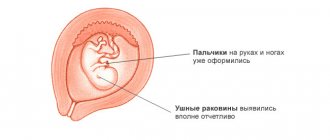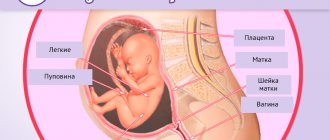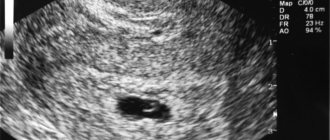The process of pregnancy is unique and has its own characteristics at certain periods. In this regard, it is important for the expectant mother to understand what stages of development occur with her unborn child at a particular period of gestation. So, with the obstetric calculation method, the 5th week of pregnancy will actually be the third from the moment of conception.
Of course, every woman is very interested to know what to expect from this period, what changes will occur in her body, how the embryo will develop. During this period, the process of restructuring and adaptation of the body to its new position continues, and the unborn child continues to grow, form and develop, the laying of all its systems and organs occurs.
Features of the fetal condition
In the fifth week of pregnancy, the fetus looks like a tube, folded into an arc. Now he can see not only his tail and head, but also the following parts of his body:
- rudiments of hands;
- fingers;
- eyes;
- ears;
- nasal and oral slits.
At this stage, the pancreas, liver, and upper respiratory tract begin to form. The length of the embryo as a whole is about 4-7 mm, and its weight is 3.5 g.
At this stage of pregnancy, the neural tube partially closes. Subsequently, the brain and spinal cord, spine and central nervous system will form from it. Therefore, the mother’s psychological state is very important , the absence of stressful situations and experiences that can negatively affect the future health of the child.
The 5th week of pregnancy is also significant because the tiny heart of the unborn baby begins to make its first beats. This occurs approximately 20-22 days after conception. The blood vessels of the embryo are also in an active stage of formation.
The fetus at this stage is surrounded by amniotic fluid. In the fifth week, metabolism improves between the mother and her unborn baby. This places a huge responsibility on the woman for the health of the unborn child; she must eat well, experience as many positive emotions as possible and contribute in every possible way to the normal development of the fetus.
It is noteworthy that at this stage it is already possible to determine the blood type of the embryo. As you know, the sex of the unborn baby was formed at the moment of conception, and at week 5 the formation of the gonads, sperm and egg occurs.
Who will help in the fight against toxicosis in the early stages?
Of course, if at the 5th week of pregnancy a woman does not feel happy and her condition is constantly accompanied by fatigue and nausea, somewhere on an unconscious level she is already ready to give up the child, if only everything would return to normal. In fact, every woman who has experienced or is experiencing a similar phenomenon has the opportunity to seek help. And these could be:
- Doctor monitoring pregnancy. Usually the doctor has, plus or minus, a clear idea of why nausea accompanies a particular woman’s pregnancy at 5 weeks. There are a number of medications that can be prescribed to improve the condition of the expectant mother. Judging by the instructions for use and the composition of these drugs, most of them are indeed safe for both the fetus and the mother herself. But whether to take these medications or not is another question.
- A qualified psychologist can help you deal with toxicosis in week 5 or any other week. The thing is that such a phenomenon can really have a deep psychological basis. This may be a hidden resentment towards a spouse or someone else, it may be simply the influence of stress or emotional fatigue, or it may be the presence of toxicosis - this is the influence of the stereotype that all women should have toxicosis. Regardless of which specialist the expectant mother turns to, it is important to take into account that the best help with toxicosis is one’s own calmness.
- Family. As in any other case, family will always play an incredibly important role in the life of every person. And the support of family and friends during pregnancy is what you need. A little more care, love and attention - perhaps the toxicosis will go away.
Every potential mother should remember that even if she experiences insane toxicosis, she should under no circumstances be angry with her future baby. This is not what he does! And if he does, it won’t be on purpose! And perhaps you shouldn’t even look for some remedy that will be effective against toxicosis? After all, this is a condition that is not happy at all, but if you think about the reasons for its occurrence and the fact that a new life is developing inside... After all, it’s worth it!
Ultrasound at 5 weeks
The gynecologist's assumptions about pregnancy can be confirmed by ultrasound diagnostics.
With the help of scanning, it is already possible to quite accurately determine the number of developing fetuses, their place of attachment in the uterine cavity, as well as generally diagnose the condition of the uterus and draw conclusions about some features of the course of pregnancy. Thanks to high-precision modern ultrasound equipment, sufficient experience and qualifications of a specialist, during diagnostics you can hear the first rhythms of the unborn child’s heart. As a rule, they become more distinct by the end of the fifth week .
Additionally > Pregnancy 2 (two) weeks - how and what happens during this period?
Reading...
What happens to the fetus and woman at 9 weeks of pregnancy
During the scan, the diameter of the amniotic sac and the coccyx-parietal size (length from the coccyx to the crown) are determined. The doctor conducting the study, based on listening to the heart rhythms and activity of the fetus, will be able to draw conclusions regarding its vital functions. Other parameters, including the baby’s weight, will not be clearly observed at this early stage.
What happens to the embryo at 5-6 weeks?
The fifth and sixth weeks of pregnancy represent a temporary watershed of embryogenesis, marking the boundary between the somite period and the beginning of histogenesis and organogenesis of the embryo. To understand what it actually is, we should remember the main stages of intrauterine development.
After fertilization of an egg by a sperm, a zygote with a diploid set of chromosomes is formed, which is a one-cell embryo. Then, from day 1 to the middle of the sixth day, the zygote actively divides without increasing cell size and first a morula is formed, and then a blastula formed by blastomeres.
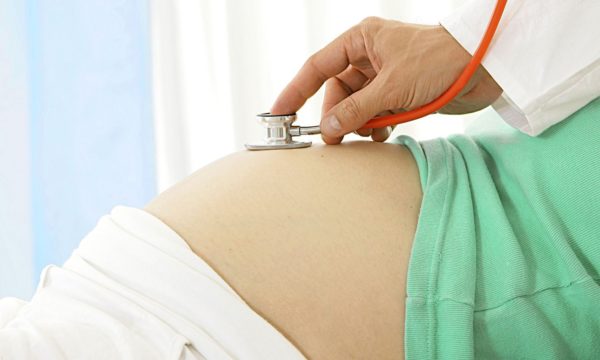
The embryonic period begins from 6 days from the moment of fertilization until the end of the ninth week. The embryonic period is extremely eventful and for this reason it is distinguished:
- Gastrulation - at this time the gastrula with germ layers is formed, the formation of axial organs occurs: notochord, neural tube, intestine (lasts from 5.5 to 21 days).
- Somite period - somites are laid, the rudiments of the very first organs are formed (lasts from the end of the third to the fifth week).
- Histo and organogenesis - all major organ systems are formed, tissue differentiation begins (from the end of 5 to the end of 9 weeks of pregnancy).
Then the fetal period begins, in which early (9-16 weeks), middle (16-24 weeks) and late (from the end of 24 weeks until birth) fetal stages are distinguished.
The milestone of 5 weeks is extremely important for the normal morphogenesis of the unborn child. Individual development is influenced by both genetic factors and external influences, which is why even identical twins can exhibit different phenotypes. Negative external influences on the embryo in the fifth week after fertilization can fatally affect the normal development of organs. During the process of antenatal development, the number of cells in the embryo and fetus increases several billion times, and this colossal process requires very fine regulation.

At 5-6 weeks, the size of the embryo is 0.4-1.0 cm. It looks like a tadpole, you can identify the head and torso, but there are no limbs yet. There are eyes, a mouth, gill slits and a tail. There is a two-chambered heart, the digestive organs are already formed and the nervous system is actively developing. In the sixth week, the placenta begins to form, through which gases, nutrients and metabolic products will subsequently be exchanged between the mother’s body and the fetus. From the sixth to the eighth week, the first peak of invasive cytotrophoblast activity is observed (the second at 16-18 weeks). In this case, the spiral arteries of the uterus open into the intervillous space and this gives rise to uteroplacental blood flow.
The time period under consideration accounts for the second critical period of embryo development: it lasts from 3 to 6 weeks and coincides with the formation of the placental bed, as a result of arrosion of the spiral arteries and villi sprouting.
Any somatic pathology that occurs during the period of 5-6 weeks can have a sad effect on the future prospects of pregnancy. Analysis of embryogenesis data during this period shows that the main areas of threat to pregnancy will be disturbances from placentation and the formation of organ anlages, in particular the nervous system. Various disorders during this period can terminate the pregnancy and lead to early miscarriage.
Characteristic symptoms and signs
The fifth week of pregnancy begins to affect the general well-being and condition of the expectant mother. First of all, an increase in the volume of the uterus plays a huge role. At the same time, it creates pressure on the bladder, and the woman may experience a frequent urge to urinate. Thus, in combination with some other features, for example, a delay in menstruation, an increase in breast size, acute perception of foreign odors, attacks of nausea, etc., a woman can make an assumption about pregnancy.
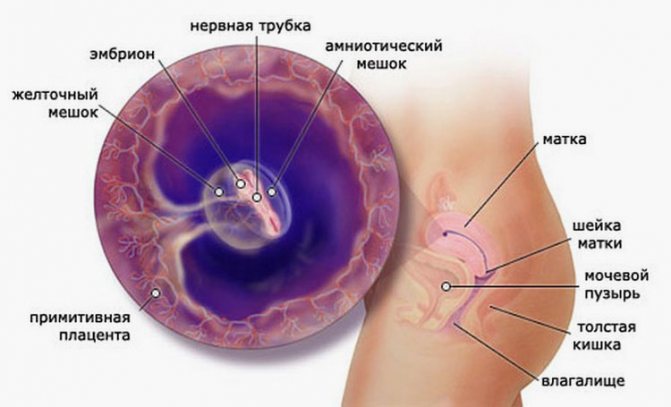
Features of breast condition
The new state of the female body will definitely affect the condition of the mammary glands. In this area, there may be some discomfort, slight tingling, irritation of the skin, as well as increased sensitivity of the nipples and darkening of the nipple area.
In some cases, a venous network appears on the chest. This phenomenon can be considered normal . Also, the expectant mother will notice how her breasts gradually begin to round and increase in size.
Feelings in the fifth week
Features of the physical condition of a woman in the fifth week of pregnancy often resemble premenstrual syndrome. Since most women may not even be aware of the onset of pregnancy at such an early stage, they associate their feelings with the upcoming menstruation. This is especially true for those women who did not plan pregnancy. As for a planned and expected pregnancy, in this case a woman can easily detect all the characteristic signs of its occurrence.
At 5 weeks, the expectant mother, having learned about her pregnancy, first of all experiences quite strong emotions. It can be happiness and incredible joy or, conversely, a feeling of confusion and surprise.
As for physical sensations, as a rule, traditional for this period will be:
- feeling of chronic fatigue;
- increased drowsiness;
- weakness, which is often confused with symptoms of colds;
- changeable mood;
- change in taste preferences;
- signs of early toxicosis, such as nausea or vomiting.
All of these symptoms are normal in early pregnancy. There is no reason for concern in this case; the expectant mother should be patient with her condition a little, because soon it will stabilize and improve. As a rule, this occurs around the 12th week of pregnancy , with the exception of rare cases when almost the entire pregnancy is accompanied by this condition.
Healthy foods
The main diet should consist of healthy foods.
It is not difficult to create a rational daily menu during early pregnancy, since the range of recommended healthy foods is quite extensive. There is a reason to use a double boiler in the kitchen more often. Stewed and boiled dishes, as well as casseroles without a large addition of oil, will not cause harm.
In terms of organizing an optimal diet, the 5th week of pregnancy does not differ significantly from subsequent periods of pregnancy. A special diet is not prescribed, but a number of necessary and healthy foods are recommended.
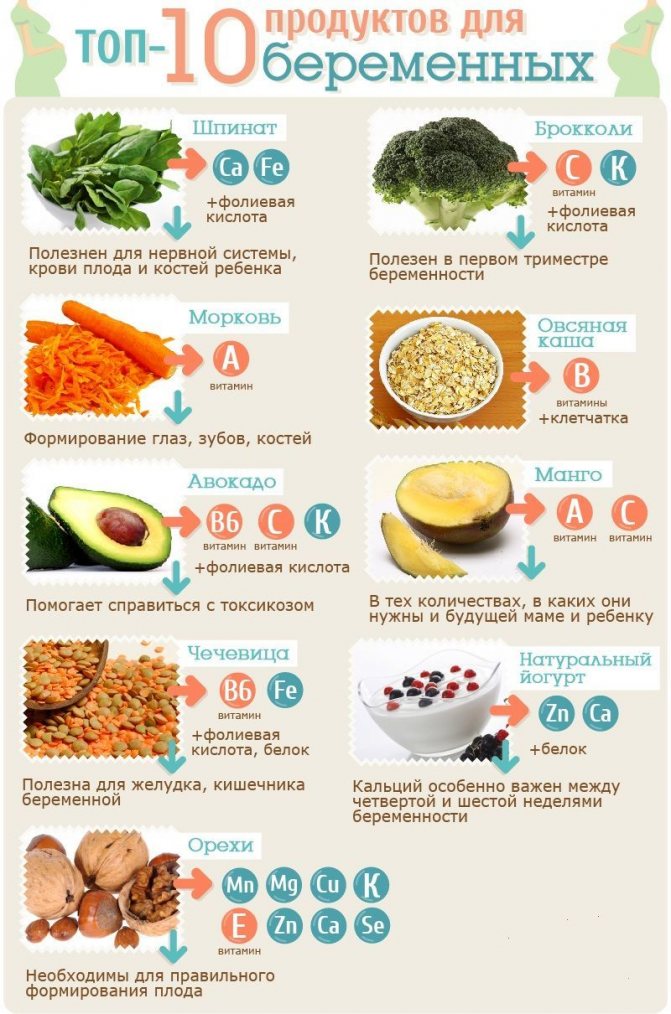
The most useful foods for pregnant women
- Coarse flour, products from which are valued during pregnancy for a number of beneficial properties. The ballast substances contained in the structural formula of such products help eliminate cholesterol. Also an important indicator is the presence of vitamin PP, which is responsible for metabolism and allows you to get rid of atherosclerotic plaques, which often form on the walls of blood vessels. It also contains other groups of vitamins, for example, B6, which reduces anxiety during pregnancy, or E, which helps strengthen the immune system.
- Cereals are included in the diet during pregnancy, helping not only to normalize digestion, but also saturating the body with a whole range of useful substances. Porridges are prepared without a large amount of oil. Their consistency can be either viscous or crumbly, prepared with water, vegetable decoctions or with the addition of milk, depending on taste preferences. During pregnancy, you can alternate daily between different types of cereals - millet, semolina, rice, oatmeal, buckwheat, pearl barley, which will allow you to diversify your diet. The nutritional value is enhanced by the addition of other ingredients to porridge - vegetables, root vegetables, herbs, nuts, dried fruits (how do dried apricots and prunes affect the body?).
Food types supplied during pregnancy with protein needed for energy balance include legumes, fish, and lean meat. Dairy products stimulate the normal development of the fetus, especially fermented milk varieties, which supply not only protein, but also calcium.
A variety of fruits, berries, herbs, and vegetables should be a mandatory component of any diet during pregnancy. The only exceptions are those species to which an allergic reaction occurs.
5 dangerous foods during pregnancy
Features of body temperature
Quite often, against the background of physical weakness and a feeling of fatigue, a woman’s body temperature may rise in the fifth week of pregnancy. The temperature can remain at the so-called subfebrile level - 37-37.2 degrees. Hormonal changes in the body of the expectant mother can also cause an increase in temperature. This phenomenon is considered completely normal, and it is necessary to sound the alarm only in cases of critical thermometer readings. In addition, other symptoms of a cold will necessarily indicate a disease or viral infection, for example, a sore throat, headache, runny nose.
Reading...
What happens in the 1st (first) week of pregnancy?
Additionally > Sixth week of pregnancy: what happens to the woman and the fetus
Changes in the body
So, let’s imagine that the 5th week of pregnancy has arrived from the moment of conception, what happens in the female body at this time?
Firstly, the very structure and condition of the skin and hair on the head changes. If the expectant mother eats well enough and carefully monitors her diet, then these changes will only progress for the better, but if the nutrients entering the body with food are not enough, then, unfortunately, they will change for the worse.
Such metamorphoses are due to the fact that at 5 weeks from the moment of conception the embryo begins to actively develop and requires as many nutrients as possible for its growth. He, so to speak, “takes” them from his bearer. It is for this reason that many pregnant women often experience an increase in appetite in the first trimester.
Secondly, on a woman’s body in the fifth week of pregnancy from conception, characteristic changes begin to appear in those two areas of the body that are most susceptible to metamorphosis during gestation: the chest and abdomen. In the mammary glands, a pregnant woman may begin to feel a slight tingling and barely perceptible discomfort, a little reminiscent of muscle soreness after active sports. There are also frequent cases of darkening of the halos and nipples, as well as their enlargement.
The abdomen, unlike the breasts, does not yet change in size during this short period of time, but a vertical stripe may unexpectedly appear on it, starting from the pubic area and ending in the navel area. Its appearance is associated with an increase in the level of hormones (melanotropin, estrogen and progesterone) in the body of a pregnant woman.
Thirdly, due to the increased development of the embryo inside the uterus, this organ of the female reproductive system begins to increase in size and put pressure on the bladder, thus causing increased urination.
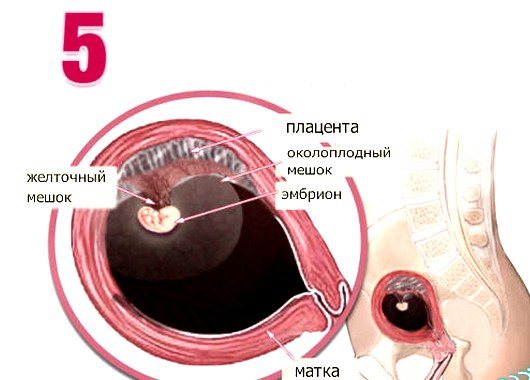
Pain in the lower abdomen
Painful sensations in the lower abdomen that resemble premenstrual pain may indicate increased uterine tone. This is a serious threat to pregnancy , as it can cause spontaneous miscarriage. Such sensations occur quite often in the early stages of pregnancy, so the expectant mother should not panic. In this case, it is better to consult a gynecologist, as well as:
- rest more;
- experience less physical activity;
- give up your favorite high-heeled shoes;
- take a horizontal position more often;
- provide temporary sexual rest.
Only an experienced specialist will be able to accurately determine the cause of such pain. It will not necessarily be the uterus, because similar sensations may be present with problems with the intestines, for example, after prolonged sitting, squeezing the torso in the abdominal area.
Vaginal discharge, bleeding and periods
If the expectant mother experiences pain in addition to bleeding, then this is a clear sign of an incipient miscarriage. If the pregnancy is planned and the woman wants to keep it, then she should immediately go to the hospital. In this case, the chances of maintaining the pregnancy are 50 percent. However, even in cases where there is no intention to save the fetus, this process should be carried out under the supervision of a doctor in order to avoid undesirable or even disastrous consequences in the future.
About a fifth of all pregnant women in their fifth week experience traditional periods, which can regularly occur during the first few months of gestation. However, they do not pose a threat of interruption at all . The nature and intensity of menstrual flow during pregnancy may not be the same for different women. In obstetric practice, this phenomenon is called “color pregnancy.”
Normally, vaginal discharge in the early stages should be translucent in color, moderate consistency, odorless and without blood. Very often, due to a weakened immune system in women, thrush begins to worsen (read how to deal with it). In this case, the discharge becomes white, and its consistency becomes more viscous and flaky. The external genitalia will be noticeably swollen and irritated, and itching and burning will be present. The disease requires timely and qualified treatment.
To avoid problems, all pregnant women need to pay due attention to their intimate hygiene. We are talking about the use of natural hygiene products and hypoallergenic cosmetics.
Among other things, the expectant mother must take care of her proper nutrition; the products present on her table should only be natural, containing the necessary vitamins and microelements. Taboos in the fifth week of pregnancy include drinking alcohol, smoking and using any medications without consulting a doctor.
- Related Posts
- Eighth week of pregnancy - how is it characterized?
- Seventh week of pregnancy - what happens to the woman and the fetus?
- Fourth week of pregnancy: discharge, changes and more
